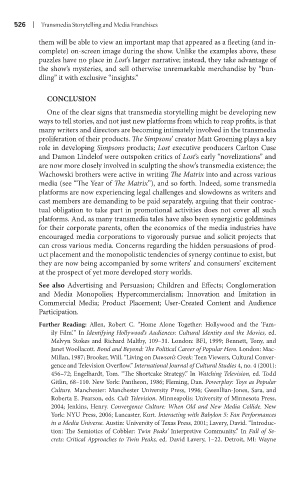Page 547 - Battleground The Media Volume 1 and 2
P. 547
| Transmed a Storytell ng and Med a Franch ses
them will be able to view an important map that appeared as a fleeting (and in-
complete) on-screen image during the show. Unlike the examples above, these
puzzles have no place in Lost’s larger narrative; instead, they take advantage of
the show’s mysteries, and sell otherwise unremarkable merchandise by “bun-
dling” it with exclusive “insights.”
ConCLusion
One of the clear signs that transmedia storytelling might be developing new
ways to tell stories, and not just new platforms from which to reap profits, is that
many writers and directors are becoming intimately involved in the transmedia
proliferation of their products. The Simpsons’ creator Matt Groening plays a key
role in developing Simpsons products; Lost executive producers Carlton Cuse
and Damon Lindelof were outspoken critics of Lost’s early “novelizations” and
are now more closely involved in sculpting the show’s transmedia existence; the
Wachowski brothers were active in writing The Matrix into and across various
media (see “The Year of The Matrix”), and so forth. Indeed, some transmedia
platforms are now experiencing legal challenges and slowdowns as writers and
cast members are demanding to be paid separately, arguing that their contrac-
tual obligation to take part in promotional activities does not cover all such
platforms. And, as many transmedia tales have also been synergistic goldmines
for their corporate parents, often the economics of the media industries have
encouraged media corporations to vigorously pursue and solicit projects that
can cross various media. Concerns regarding the hidden persuasions of prod-
uct placement and the monopolistic tendencies of synergy continue to exist, but
they are now being accompanied by some writers’ and consumers’ excitement
at the prospect of yet more developed story worlds.
see also Advertising and Persuasion; Children and Effects; Conglomeration
and Media Monopolies; Hypercommercialism; Innovation and Imitation in
Commercial Media; Product Placement; User-Created Content and Audience
Participation.
Further reading: Allen, Robert C. “Home Alone Together: Hollywood and the ‘Fam-
ily Film’. ” In Identifying Hollywood’s Audiences: Cultural Identity and the Movies, ed.
Melvyn Stokes and Richard Maltby, 109–31. London: BFI, 1999; Bennett, Tony, and
Janet Woollacott. Bond and Beyond: The Political Career of Popular Hero. London: Mac-
Millan, 1987; Brooker, Will. “Living on Dawson’s Creek: Teen Viewers, Cultural Conver-
gence and Television Overflow.” International Journal of Cultural Studies 4, no. 4 (2001):
456–72; Engelhardt, Tom. “The Shortcake Strategy.” In Watching Television, ed. Todd
Gitlin, 68–110. New York: Pantheon, 1986; Fleming, Dan. Powerplay: Toys as Popular
Culture. Manchester: Manchester University Press, 1996; Gwenllian-Jones, Sara, and
Roberta E. Pearson, eds. Cult Television. Minneapolis: University of Minnesota Press,
2004; Jenkins, Henry. Convergence Culture: When Old and New Media Collide. New
York: NYU Press, 2006; Lancaster, Kurt. Interacting with Babylon 5: Fan Performances
in a Media Universe. Austin: University of Texas Press, 2001; Lavery, David. “Introduc-
tion: The Semiotics of Cobbler: Twin Peaks’ Interpretive Community.” In Full of Se-
crets: Critical Approaches to Twin Peaks, ed. David Lavery, 1–22. Detroit, MI: Wayne

